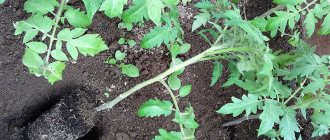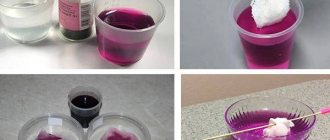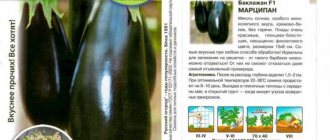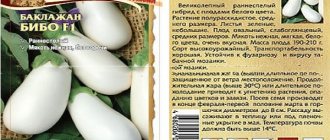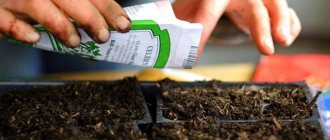Eggplant Violet miracle F1 is a universal and easy-to-care hybrid. It is suitable for any vegetable dishes and winter preparations. It can be grown both in open ground and in a greenhouse. The hybrid has high commercial qualities and resistance to diseases.
| Origin | Landing location | Ripening period | Fruit color | Fruit weight | Fruit shape |
| Hybrid | Open ground | Early ripening | Dark purple | 100-350 g. | Cylindrical |
Description of the variety Purple Miracle
The variety does not like extreme heat. On especially hot days, the growth of fruits and bushes stops. As a result, the harvest is delayed by several weeks.
Description:
- from the moment of seedling germination to technical maturity, 95-100 days pass;
- The length of the fruit reaches 20 centimeters. Diameter – 4-6 centimeters. Maximum weight – 135 grams;
- fruits are cylindrical, dark purple in color;
- A harvest of up to 8 kilograms is harvested per square meter. In a greenhouse - up to 13 kilograms;
- suitable for preservation;
- The dense, greenish-white flesh has a pleasant taste without bitterness.
Behemoth F1
The Behemoth variety bears the name of a large animal for a reason. This plant can reach a height of 2 m, so it is suitable for growing only in high greenhouses.
The black-purple fruits grow up to 20 cm in length and are shaped like a pear. Their flesh is white with a greenish tint. This variety is highly valued for its excellent presentation and taste of the fruit, as well as good yield (it is 2-3 times higher than many eggplant varieties).
| Purpose | Growing | Ripening time (days) | Fruit weight (g) | Productivity (kg/sq.m) |
| 101-110 | 322-340 | 14-17 | ||
Characteristics of eggplant
Purple miracle is a hardy variety that does not require special care.
Characteristics:
- bushes are semi-standard, compact;
- suitable for open ground;
- foliage is slightly pubescent, green;
- there are no large spines on the calyx;
- Purple miracle is an early ripening variety;
- fruits have a long period of transition from technical maturity to biological maturity;
- maximum height of bushes – 90 centimeters;
- eggplants tolerate transportation well and are characterized by their ability to be stored for a long time;
- even in bad weather conditions the bush forms ovaries.
Purple Haze
The stem of the plant reaches a height of 60 cm and is distinguished by strong pubescence. The rich green leaves are very smooth, without jagged edges. The fruits are oval in shape, the skin color is usually lilac-lilac, and the flesh inside is white, without bitterness.
This variety has become popular among gardeners due to its good resistance to blossom end rot and attractive fruit color.
The Lilac Fog variety is recommended for cultivation in all regions of Russia.
| Purpose | Growing | Ripening time (days) | Fruit weight (g) | Productivity (kg/sq.m) |
| 100-105 | 110-270 | 6-6,5 | ||
Growing eggplants in open ground
Purple miracle is profitable to grow in open ground. The bushes easily tolerate temperature changes and produce a bountiful harvest. Even the smallest bushes produce several large fruits. To get maximum yield, follow simple recommendations.
Landing dates
The seedlings are transplanted into the ground 40-50 days after sowing the seeds. Therefore, seeds are planted in the second ten days of March.
Soil preparation
An important factor influencing the development of the bush and yield is the planting location. Choose a neat and sunny area. Also, fruit growth depends on the crops that grew in the garden last season.
It is not recommended to plant after:
- potatoes;
- tobacco;
- peppers;
- eggplant.
It is recommended to plant after:
- greenery;
- melons;
- legumes.
See also
Description of the Long Purple eggplant, its characteristics, pros and consRead
Soil preparation begins in the fall:
- A mixture of fertilizers is distributed in an even layer on the beds. Use mineral and organic;
- dig up.
In the spring, they dig up again and form beds. The recommended width is 70 centimeters. The row spacing is 60 centimeters.
Preparing seedlings
For seedlings, special containers are used, with a separate section for each sprout, or pots.
Seed preparation:
- The seeds are checked for germination. To do this, they are placed in water and left for three hours. Empty seeds will float on the surface. They cannot be used for sowing.
- Those that have fallen to the bottom are laid out on moistened gauze, which is rolled up in several layers. Keep warm for 6 days. Occasionally spray with a spray bottle.
Before sowing the seeds, the soil is calcined in an oven. Use special soil designed for eggplants. Sprouted seeds are placed in the soil to a depth of three centimeters. Then water generously and cover with film.
Store in a dark place. The ideal temperature is 25 degrees.
After 7 days, the first shoots will begin to appear. The film is removed and the containers are moved to the windowsill. To ensure uniform growth of seedlings and root systems, seedlings periodically turn in the direction against which the sprout is stretching.
Landing
A month before transplanting, they begin to harden the seedlings. The containers are exposed to open air for a couple of hours, gradually increasing the residence time. To protect plants during this period from diseases, the bushes are sprayed with a weak solution of copper sulfate. By the first days of June, the seedlings are fully formed and ready for transplanting.
Important rules:
- on the day of transplantation, in the morning, dig holes at a distance of 45 centimeters from each other;
- pour plenty of water and leave until evening. It is recommended to replant bushes after sunset;
- containers with seedlings are filled with water. Carefully move the bushes with a lump of earth into the hole;
- water and, compacting, sprinkle with dry soil.
Lists of varieties according to various characteristics
Purple miracle is a hybrid variety of eggplant that can be grown both in open areas and in protected ground. It cannot be called unpretentious, since a novice gardener may have some difficulties with agricultural technology. But all efforts will be rewarded a hundredfold with a wonderful harvest of beautiful and tasty vegetables.
The fruits of the Purple Miracle are universal, since these eggplants can be used to prepare savory snacks and caviar. Vegetables are great for canning and pickling. Eggplants of this variety are perfectly stored both fresh and frozen. By the way, after freezing the fruits do not lose their excellent taste. A lot of reviews have been written about the variety. Most of them are positive.
| Main characteristics of the variety | |
| Variety | Hybrid |
| Ripening time | Early ripening group (from 95 to 100 days) |
| Resistance to common crop diseases | Verticillium wilt |
| Fruit storage period | Long lasting |
| Marketable condition | High |
| Taste qualities | Excellent |
| Description of the fruit | |
| Color | Dark purple |
| Form | Classic oval-cylindrical |
| Pulp | Pale green color and dense texture |
| Size | Medium-fruited |
| Weight | From 100 to 350 g |
| Description of the plant | |
| Height | From 70 to 90 cm |
| Bush shape | Compact |
| Features of the cup | Little or no thorns |
| Features of cultivation | |
| Place | Greenhouses and open ground, under film cover |
| Age of seedlings for transplantation | 40 to 50 days |
| Allowable number of bushes per 1 m² of area | 4-6 |
| Crop rotation | After melons, legumes, carrots and greens |
Agronomists who have experience growing the variety willingly leave their reviews with descriptions and photos of the eggplant harvest. The fruits are widely used in all areas of cooking: baking, frying, canning, pickling vegetables, as well as in preparing complex dishes with the addition of vegetables.
There are usually no difficulties in growing seedlings of this hybrid. Representatives of the variety do not require additional care or the creation of specific conditions. Seedlings are prepared according to the basic standards for growing eggplants.
READ MORE: Apple tree ligol variety description photo reviews
The only distinguishing point is the correct determination of planting dates. Seedlings of this variety are ready for planting already on the 40-50th day after germination.
At the time of transplantation, the soil should be sufficiently warmed up. Therefore, despite the variety belonging to the early ripening category, the seeds are planted no earlier than the second half of March.
The timing of planting seeds of this variety depends on the climatic characteristics of the region in which it is planned to grow eggplants. Seeds are sown 2 months before the planned planting of seedlings in the OG.
The seeds are buried 1 cm in moist soil. Until they germinate, the seed containers are covered with film or glass.
After germination, the cover is removed.
This variety, like all other eggplants, does not tolerate transplantation well. Therefore, it is recommended to sow in separate containers. If the seeds were planted in a common container, the grown seedlings are picked at the stage of 2 true leaves.
Lighting
This variety of eggplant is undemanding to lighting conditions. Seedlings are grown in compliance with standard requirements:
- Containers with seeds are brought out into the light only after germination.
- The duration of daylight should be from 10 to 12 hours a day.
Seedlings are placed on the south, southwest or southeast side. Northern windows will not be able to provide plants with the required amount of light. Such seedlings will have to be illuminated with phytolamps.
Daylight hours shorter than 10 hours will cause slow growth of seedlings. Such bushes will not be ready for planting in the ground as planned. A large amount of light will cause the seedlings to stretch. Such eggplants adapt less well when transplanted into the exhaust zone.
The hybrid is drought-resistant. Plants tolerate poor watering better than waterlogged soil. But for normal development and growth of plants, the soil is kept moist.
The seedlings are watered by irrigation from a spray bottle. It is impossible to pour water on the soil due to the possible washing of seeds from the soil. Irrigation is carried out daily. It is advisable to water the plants early in the morning.
All eggplants are demanding on the temperature of irrigation water. It should be no colder than 25⁰. When using cold or overheated water, plants slow down or stop their growth altogether.
Planting seedlings in open areas of soil has its own characteristics. Mistakes made during transplantation and improper care of plants can leave the vegetable grower without a long-awaited harvest.
The area for eggplants is prepared in advance. When choosing a place in the exhaust zone, the gardener should adhere to the following recommendations as much as possible:
- avoid low-lying areas - potential places where precipitation accumulates;
- absence of drafts;
- not shaded area.
In autumn, the soil is enriched with organic fertilizers. In the spring it is dug up again and all weeds are removed.
It is recommended to harden off the seedlings before planting them in the garden. A month before the planned planting, it is taken out into the fresh air. Starting from 2 hours, the time spent by young bushes on the street is gradually increased. A few days before planting, seedlings are not brought into the room.
It is advisable to replant the bushes after sunset. But the holes for seedlings are prepared in the morning.
The soil is loosened well with a rake. Then dig holes at a distance of 45 cm from each other. Leave at least 60 cm between rows. The dug holes are heavily filled with water.
In the evening, containers with seedlings are also filled with water and left for a few minutes. When the substrate is well saturated with moisture, the bushes are carefully removed along with the earth ball.
Eggplants are watered frequently, but with a moderate amount of water. Purple Miracle tolerates drought better than waterlogging, so it is not recommended to over-water the bushes.
Usually watering is done every 2-3 days. If the weather is very hot, the bushes are watered daily. Water is poured only at the root. Moisture on the leaves of the plant has a detrimental effect.
Water for irrigation should not contain salts or chlorine. Even rainwater is left to settle for at least a day. The optimal temperature of irrigation water is from 20 to 28⁰.
Watering is done early in the morning or after sunset. Watering plants in full sun is not recommended due to strong evaporation.
Feeding
- 2 weeks after planting, mineral fertilizers are introduced to the plants.
- 3 weeks after the first feeding with a mixture of organic minerals.
- At the beginning of the fruiting period, a combination of organic and mineral substances.
For the first feeding, 40 g of superphosphate, 20 g of potassium salt and 30 g of ammonium nitrate are dissolved in 1 bucket of water. To prepare the mixture for the second feeding, take 30 g of urea, 80 g of superphosphate and 40 g of potassium salt per 10 liters of water. For the third feeding, use 70 g of urea, 20 g of potassium chloride and 70 g of superphosphate, diluted in 1 bucket of water. After each application of fertilizers, the soil around the plants is moistened with water.
Wood ash has a beneficial effect on eggplants. The beds are sprinkled with it a week after each feeding.
The variety is resistant to spider mites. But you have to save the plant yourself from the Colorado potato beetle and aphids.
Colorado potato beetles pose a serious danger to blue beetles. With a massive infection, they are able to eat all the leaves on the bush in just a day.
Aphids eat leaves less quickly, but are also capable of causing significant damage to a plant infected by it.
Before the fruiting period begins, chemicals called insecticides can be used against pests. The use of such a product on bushes with fruits may pose a threat to the health of the person who will eat these vegetables. Therefore, if the plants are infected during fruiting, the pests are collected by hand and destroyed.
The hybrid is resistant to Verticillium wilt. Cases of plant disease with other diseases common to eggplants occur solely through the fault of the vegetable grower.
- Early ripening of eggplants. We grew it in a greenhouse and harvested it in August.
- Unlike some other varieties, the pulp of the Miracle is not bitter.
- Good disease resistance - not a single bush got sick all summer.
- High level of productivity. I followed all the care recommendations and had eggplant dishes on the table every day.
READ MORE: Luna tranquility fungicide instructions for use of the drug consumption rates
I noticed only 2 drawbacks: the bushes need to be watered often and they do not tolerate heat well.”
The hybrid has a lot of advantages and only some disadvantages. But if you follow the recommendations of agricultural technology, you can harvest a good and high-quality harvest.
Application
Watch the video! Eggplant variety Violet miracle
Reviews, who planted
Reviews from gardeners about the eggplant variety Violet Miracle are extremely positive.
How to care for the “Purple Miracle”
During the entire growth period, you will have to regularly perform simple actions:
- watering;
- feeding;
- weeding.
Watering and weeding
Eggplants need moist soil. For irrigation use settled water. After transplanting, the bushes are watered at the root. After the liquid is absorbed, the soil around the plant is loosened. When the plants take root, water is released into the furrows. Watering is carried out in the evening hours, after sunset.
Eggplants cannot grow normally when adjacent to weeds, so you will need to constantly weed the beds.
Fertilizer
The bushes are fed for the first time two weeks after transplantation. To do this, mix:
- 10 liters of water;
- 40 grams of superphosphate;
- 20 grams of potassium salt;
- 30 grams of ammonium nitrate.
See also
Description and treatment of eggplant diseases, their pests and methods of controlling themRead
Chicken manure diluted in 10 liters of water with 200 grams of ash is also used for feeding.
After three weeks, a second feeding is carried out. Fertilize with a solution:
- 10 liters of water;
- 40 grams of potassium salt;
- 80 grams of superphosphate;
- 30 grams of urea.
The third feeding is carried out at the beginning of fruiting with the prepared solution:
- 20 grams of potassium chloride;
- 70 grams of urea;
- 10 liters of water;
- 70 grams of superphosphate.
To avoid burning the bush, after fertilizing the soil is spilled with clean water.
A week after fertilizing, you can additionally fertilize the soil with wood ash. She:
- helps contain the spread of rot;
- thanks to the potassium it contains, it improves the taste of fruits;
- helps protect bushes from slugs and slugs;
- alkalizes the soil.
Sprinkle the beds with ash after watering.
Bush formation
To enhance the branching of the tops of the bushes, pinch out the grown stems at a height of 30 centimeters. To prevent the formation of small fruits, constantly pay attention to the correct formation of plantings.
Each bush should have:
- 5 side shoots;
- 7-8 ovaries.
During the entire period of bush growth, yellowed foliage is removed.
If you follow all the recommendations, the Purple Miracle will give a bountiful harvest of strong, tasty fruits.
How to germinate seeds?
Early eggplant variety Violet miracle. It is planted as seedlings in the ground if the air has warmed up to a temperature of 20 C, the soil is 15 C. In this case, sowing is carried out at the end of March. Seedlings are planted at the end of May, in mid-June. The fruits will appear in mid-June or early July.
If a heated greenhouse is prepared for eggplant, then sowing is done at the end of February. It maintains a constant temperature of 20-25 C.
The film protects plants from frost, precipitation and wind. In such favorable conditions, seedlings are planted in early May. The berries will ripen in early June.
Before sowing eggplants, it is necessary to separate the good material from the total number of seeds. Normally, they should be flat and light brown in color.
They are treated with potassium permanganate, kept in cold water or saline solution and wrapped in a moistened napkin. The average ripening temperature is 14 C, sprouts appear after 5 days.
To increase the immunity of seeds and to accelerate the emergence of sprouts, growth stimulants and Humates are used. Epin is used as a growth stimulator. It is diluted with warm water 20 C: 2 g/10 l.
Potassium humates are used: for 10 liters take 1 tbsp. l. In the future, the solutions can be used to irrigate the soil and seedlings.
Protection from diseases and pests
Bushes are often attacked by:
- white and green aphids;
- Colorado beetle.
The bushes are regularly inspected. If insects are found, treat them with a tobacco-soap solution. The procedure is carried out in the evening. Drops of water under the influence of the sun leave burns on the leaves, which often leads to the death of the bushes.
Colorado beetles pose a great danger to bushes, as they can completely eat all the leaves within a day.
Before the first ovaries appear, insects can be controlled using chemicals. The beetles are then collected by hand. A fine net stretched around the bushes helps prevent insect attacks. A sufficient height is a meter. The beetles will not be able to climb higher.
The plant is resistant to:
- spider mite attacks;
- verticillium wilt.
Collection and storage
The variety has a long fruiting period. The harvest is harvested before the first frost, around October. Twice a week, bushes are inspected for the presence of fruits that have reached technical maturity. For long-term storage, the fruits are cut off along with the stalk. Mature specimens are placed in a dry room with a temperature of 4-6 degrees. After two weeks, the fruits are sorted, leaving only strong, undamaged specimens. Wipe with a dry cloth. Wrap in thick paper and store for up to three months.

